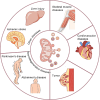Mitochondria-derived vesicles: A promising and potential target for tumour therapy
- PMID: 40356246
- PMCID: PMC12069804
- DOI: 10.1002/ctm2.70320
Mitochondria-derived vesicles: A promising and potential target for tumour therapy
Abstract
Mitochondria-derived vesicles (MDVs) participate in early cellular defence mechanisms initiated in response to mitochondrial damage. They maintain mitochondrial quality control (MQC) by clearing damaged mitochondrial components, thereby ensuring the normal functioning of cellular processes. This process is crucial for cell survival and health, as mitochondria are the energy factories of cells, and their damage can cause cellular dysfunction and even death. Recent studies have shown that MDVs not only maintain mitochondrial health but also have a significant impact on tumour progression. MDVs selectively encapsulate and transport damaged mitochondrial proteins under oxidative stress and reduce the adverse effects of mitochondrial damage on cells, which may promote the survival and proliferation of tumour cells. Furthermore, it has been indicated that after cells experience mild stress, the number of MDVs significantly increases within 2-6 h, whereas mitophagy, a process of clearing damaged mitochondria, occurs 12-24 h later. This suggests that MDVs play a critical role in the early stress response of cells. Moreover, MDVs also have a significant role in intercellular communication, specifically in the tumour microenvironment. They can carry and transmit various bioactive molecules, such as proteins, nucleic acids, and lipids, which regulate tumour cell's growth, invasion, and metastasis. This intercellular communication may facilitate tumour spread and metastasis, making MDVs a potential therapeutic target. Advances in MDV research have identified novel biomarkers, clarified regulatory mechanisms, and provided evidence for clinical use. These breakthroughs pave the way for novel MDV-targeted therapies, offering improved treatment alternatives for cancer patients. Further research can identify MDVs' role in tumour development and elucidate future cancer treatment horizons.
Keywords: mitochondria‐derived vesicle; target; transport pathway; tumour progression; tumour therapy.
© 2025 The Author(s). Clinical and Translational Medicine published by John Wiley & Sons Australia, Ltd on behalf of Shanghai Institute of Clinical Bioinformatics.
Conflict of interest statement
The authors declare that they have no competing interests.
Figures





Similar articles
-
Mitochondria break free: Mitochondria-derived vesicles in aging and associated conditions.Ageing Res Rev. 2024 Dec;102:102549. doi: 10.1016/j.arr.2024.102549. Epub 2024 Oct 19. Ageing Res Rev. 2024. PMID: 39427885 Review.
-
In vitro study on the promotion of osteogenic differentiation by mitochondrial-derived vesicles through activation of inflammation and reprogramming of metabolic pathways.J Orthop Surg Res. 2025 Apr 17;20(1):388. doi: 10.1186/s13018-025-05749-5. J Orthop Surg Res. 2025. PMID: 40247396 Free PMC article.
-
Defects of mitochondria-lysosomes communication induce secretion of mitochondria-derived vesicles and drive chemoresistance in ovarian cancer cells.Cell Commun Signal. 2024 Mar 6;22(1):165. doi: 10.1186/s12964-024-01507-y. Cell Commun Signal. 2024. PMID: 38448982 Free PMC article.
-
Mitochondrial-derived vesicles: Gatekeepers of mitochondrial response to oxidative stress.Free Radic Biol Med. 2022 Aug 1;188:185-193. doi: 10.1016/j.freeradbiomed.2022.06.233. Epub 2022 Jun 21. Free Radic Biol Med. 2022. PMID: 35750270 Review.
-
Mitochondria-derived vesicles and their potential roles in kidney stone disease.J Transl Med. 2023 May 2;21(1):294. doi: 10.1186/s12967-023-04133-3. J Transl Med. 2023. PMID: 37131163 Free PMC article. Review.
References
-
- Rongvaux A. Innate immunity and tolerance toward mitochondria. Mitochondrion. 2018;41:14‐20. - PubMed
Publication types
MeSH terms
Grants and funding
LinkOut - more resources
Full Text Sources
Medical
